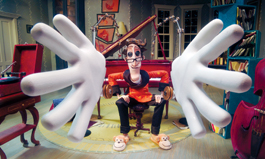home | metro silicon valley index | movies | current reviews | film review

Laika Entertainment/Focus Feature
HAND JIVE: Other Father helps out at the piano in 'Coraline.'
Wonderwall
Henry Selick's stop-action marvel 'Coraline' gives full rein to a girl's imagination
By Richard von Busack
CHILDREN who grew up with The Nightmare Before Christmas would be surprised to learn that it was once considered too frightening for children.
Children under 5 might want to be elsewhere, but everyone else with a fanciful streak should love Coraline, a stop-motion animated masterpiece by Nightmare's director, Henry Selick.
Adapted from a Neil Gaiman book, the story contains elements from Alice in Wonderland, E.T.A. Hoffmann's "The Nutcracker and the Mouse King"—and there's a spot of help from Keats' poem "La Belle Dame Sans Merci." In 3-D (the format in which it must be seen), this is a fascinating and strangely beautiful tale.
A bright-blue-haired Oregon girl discovers a magical portal and takes up a chimerical parallel existence just on the inside of her new house's wall. Coraline, voiced by Dakota Fanning, could use some escape. Her blue hair is the sharpest color in a muddy landscape soaking in the worst of the spring rains. Coraline's new house place is a pale-pink Victorian on the outskirts of Ashland. The plumbing is bad, and water bugs and centipedes wriggle out of the woodwork. Her parents work at home, drudges chained to their computer keyboards.
Coraline pays some little attention to her neighbors, theatrical retirees who were likely drawn to Ashland by the Shakespeare Festival. In the basement apartment lives a pair of broken-down English burlesque artists (Jennifer Saunders and Dawn French). The ladies live with a horde of Scotties, most of whom are dead. The tenant above Coraline's place is a bulgy Russian acrobat (Ian McShane). Nearby, a boisterous kid named Wybie roars around in the mud on a minibike. He's adopted a beat-up stray cat. Coraline has little use for the boy and his pet.
The discovery of a button-eyed doll begins the adventures. We saw this dolly at first before the title, autopsied and turned inside out in front of us by mechanical fingers made of sewing needles. Exploring her house, Coraline finds a locked crawl space. When she at last breaks through, she discovers a glowing blue tunnel. At its other end, her Other Parents are waiting for her. They're sweet and attentive, and there are no dismal computers in sight. They load Coraline's plate with cakes, flatter her and charm her and tend an animated garden of plants celebrating her existence. The only hitch is that this Other Mother and Other Father have shiny black Raggedy Ann–style buttons for eyes.
Coraline's help in the trouble to come is the skeptical feral cat, who goes as he pleases between worlds. The cat is voiced with lovely insinuation by Keith David. This spindly legged alley cat may represent the film's tenderest animation. Selick captures the nerves, the mystery and the savageness of the animal. At one point, the Cat commits a calm act of violence, murdering a mouse with one snap of his jaws. It's an echo of the single greatest moment in Rose McGowan's acting career, her final scene in Selick's Monkeybone. There, her silky catwoman Kitty proved she was as much cat as woman.
The 3-D used here is not just a technical gimmick. If Selick has something in common with Tim Burton, it's the Burton of Beetlejuice. Troubling changes of size occur in the fantasy world, in the same way that the zebra-striped demon Beetlejuice was sometimes man-size, sometimes a scuttling mouse. The revelation of the Other Mother's true self comes with a startling change of size and proportion. Selick's plays on both sides of the line between the uncanny and the cute; asymmetry, strange angles and disproportions rule the creatures in the fantasy world.
Still, Coraline's tougher-minded side occurs in the real world. There's a touch of weariness in the way Coraline's real Mother deals with her dissatisfied daughter. After trying to talk her child into wearing a drab school uniform, she utters a toneless "Well, I tried." (Her refusal to butter up the girl is exactly the way it happens in real life.)
Coraline is girl-centric, and this may be deliberate. Perhaps it was the thousands of goth (or merely offbeat) girls out there who responded the most deeply to Skellington and Sally. The changing rapport between mom and daughter (as well as between the not-mom and daughter) makes this a very womanly tale. The men are off to the side in a power struggle between maiden, mother and very bad crone.
Watching fairy-tale films, too often you're tensed up, worrying that you will be fed a trite motto that will spoil the pleasure. Coraline has its moral, an Old Country one: Those who gorge us on sweets may not have our best interests at heart.
But Coraline's symbolism seems artful and troubling, rather than simple. As in the Grimm Brothers stories, there's something very pagan in Coraline, something that doesn't jibe with our feelings that good always defeats evil. Rather it insists that cleverness and a little treachery is always needed to save our skins.
![]() CORALINE (PG; 100 min.), directed by Henry Selick, based on the book by Neil Gaiman and with the voices of Dakota Fanning, Teri Hatcher and Keith David, opens Feb. 6.
CORALINE (PG; 100 min.), directed by Henry Selick, based on the book by Neil Gaiman and with the voices of Dakota Fanning, Teri Hatcher and Keith David, opens Feb. 6.
Click Here to Talk About Movies at Metro's New Blog
Send a letter to the editor about this story.
|
|
|
|
|
|